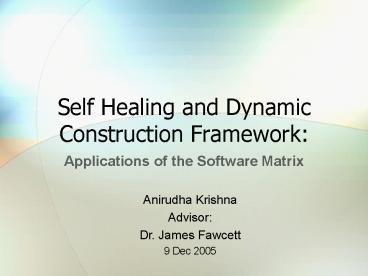Self Healing and Dynamic Construction Framework: PowerPoint PPT Presentation
1 / 29
Title: Self Healing and Dynamic Construction Framework:
1
Self Healing and Dynamic Construction Framework
- Applications of the Software Matrix
Anirudha Krishna Advisor Dr. James Fawcett 9
Dec 2005
2
Goals of the Research
- Exploring ideas to simplify design of complex
systems - Reuse
- Configurability
- Automation
- Build a Framework to enable systems to Self Heal
- Explore the usability of the Software Matrix in
this context
3
Self Healing and Dynamic Construction
- Self Healing System that is able to recover
from failure without external intervention - Dynamic Construction System that can add
functionality to itself at run time - Software Matrix Cell based development model
focused on reuse
4
Matrix Framework
- Framework for Reuse
- Integrated Network of Cells
- Dynamic Application Composition
- Mediator based Communication
5
Matrix Framework
- Five Elements of the Software Matrix
- Cell
- Mediator
- Message Passing Support
- Executive
- Network Support
6
Matrix Cell
- Four Components
- Cell ID
- Message Passing Structure
- Capability List
- Processing
7
Matrix Messaging
- Mediator centric Communication
- XML Based Messages
- Synchronous and Asynchronous Message Passing
- Common Local and Network Message Formats
8
Matrix Executive
- Directory Watcher
- Reflection to load Cells
- Common Interface Register Function
- Start Cell Initialization
- Application Startup
9
Additions to the Matrix Network Support
- Replaceable Network Cell
- Provides both Server and Receiver Functions
- Provision for specifying Network Destinations for
Messages - Asynchronous and Synchronous communication
- Concept of Matrix Node
10
Self Healing Architecture
- Matrix Style Cell Based Framework
- Recover from Cell / Node Failures
- Three main components
- Default Handler Detect Failures
- Address Server Locate Message Handlers
- Repository Server Restore Failed Cells
- Configurable to required level of functionality
11
(No Transcript)
12
Address Server
- Maintains a Address table of Message Handlers and
their locations - Contains logic for evaluating a request as a Cell
failure or lack of Addressing Information - Requests reload from Repository and manages
installation of new Cell - Provides capability for recovering from
Repository Server Failures
13
(No Transcript)
14
Default Handler
- Receives Messages from
- Failed deliveries Network / Local
- Destination not specified
- Maintains cache of Network Addresses
- Discovers new Address either from local cache or
by contacting the Address Server
15
Default Handler
- Forwards the failed message to the new
destination - Supports Recovery from Address Server Failures
- Provides information on Message Handling
capabilities of the node
16
Repository
- Maintains a static store of all Cells used by the
Application - Responds to queries requesting Message Handlers
by identifying and retrieving the required File - Provides support for runtime startup after Failure
17
(No Transcript)
18
Application Cell Failure
- Failure of Node detected by Network Cell
- Message Forwarded to default handler
- Request to Address Server generates Reload from
Repository - Default Handler forwards original message to new
location
19
Framework Cell Failure
- Applications Restored by Framework
- What if Framework Cell fails ???
20
Restoring Framework Components
- Possibility that Address Server or Repository
fails - Two options
- Maintain mirror servers
- Enable framework to heal itself
- Advantages and Disadvantages to each scheme
- Data Restoration on startup
21
Framework Configurability
- Ability to utilize only as much of the Framework
as required - Complete Self Healing framework consisting of
Address Server, Default Handlers, Repository,
File Handlers and Network Cells - Minimal system consisting of just a pared-down
Default Handler
22
Test System Simulated Radar Management
- Three components
- Radar Display
- Data Analysis
- Field Console
- Automating Recovery from Failure
- Failure Test
23
Simulated Radar Management
- Operational Radar System
24
Simulated Radar Management
- Normal Operation on Four Machines
- Failure of the Data Analysis Module repaired by
the Framework - Failure of a Framework Component Address Server
- Address Server restored
- Data Analysis restored
25
Timing Test
- Test Results one time recovery delay before
normal operation resumes
26
Thesis Conclusions
- Key Feature reduce complexity
- Reduction of complexity in application design
complemented by simplifying tools used - Raise Abstraction to Cell level through efficient
reuse of existing Cells - Use of automation to build more robust
applications
27
Thesis Conclusions
- Simple Self Healing is possible
- Dynamic Construction over a distributed system
can work effectively - Efficient reuse can minimize the coding effort to
allow applications to be built by putting files
together
28
Future Work
- Removing the Mediator centric messaging from
production quality Matrix Applications - Generic Multithreaded Server Cell design for high
bandwidth Applications - Multiple Service Providers
- Adding other automation services self
configuring, self protecting, self optimizing - Sophisticated Network Cells
29
Thank You.

